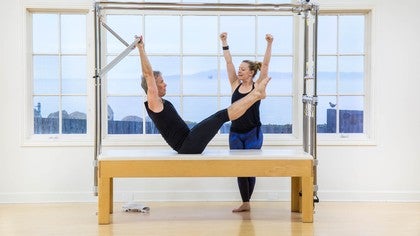Strong Cadillac Flow
Amy Havens
Class 3423
Watch this Class


Marina C
1 person
likes this.
Wow Amy, great class!! I feel soooo long and energized🤩thank you!
3 years ago
I like this class but the cues were not as easy to follow and as clear as usual … prob the male energy makes a shift - still a great lateral stretch at the end 👍
3 years ago
curious to know if it is not necessary to do chest lifts in neutral spine? because some teachings anchor that exercise with a neutral spine
18 days ago
Hello Manasa Kannan, you are bringing up a wonderful point to discuss, thank you. I'll start with posing the thought ... "what's neutral?" I believe we'll agree that we're referring to the ASIS and pubic symphysis being on the same plane as well as the posterior ribcage, ribs 11 and 12, being connected to the surface. I feel the challenge here is complex in that -- every person's anatomy and skeletal design and shape is different. Even though these landmarks might be 'aligned' and look 'neutral', they may need to slightly change the position of that pelvis to a slightly posterior angle in order to feel the contraction of the deep abdominals primarily. I realize that many trainings ask for 'neutral spine' during a chest lift, however, neutral spine and neutral pelvis might be different. I stress the belief that I need to look at the client in front of me before I give a blanket cue for positioning. Everyone is different. Stay connected if you'd like to explore this further.
15 days ago
Amy Havens thank you so much for sharing Amy! While I do not have an extensive knowledge on anatomy, what I have learnt is finding that little gap between the low back and the mat which seems comfortable and not forced and that "seems" to be the natural curve of the spine. I do agree that working with the person in front of you is the best way to gauge it, although I feel that it gets a little tricky in online or group class setting. While us Pilates instructors don't encourage causing discomfort in the pelvis/spine by forcefully tucking it in while doing ab work, it definitely makes sense to cue neutral and work with the range of the client in front of us knowing what feels good for them during the exercise! I would love to explore more with you, you are truly inspiring as I continue taking my observation hours in this platform!
14 days ago
Manasa Kannan thank you for responding to my response. This is a great conversation! I think we're agreeing... and of course, never to forcing someone into 'tucking', rather, the suggestion could be for someone to slightly, slightly bias towards posterior tilt to garner more connection to abdominal contraction. Not everyone needs to say 'neutral' or should. That little gap between the low back and the mat that you're referring to will (and should) disappear when the upper body comes up into forward flexion. It's a physics thing, and yes, we still want the ASIS and pubic bone to be in the same plane. However, as stated before, this may not be possible so a slight posterior bias is recommended and that might be how they always do this movement. It's somewhat of a mystery as to what each person's true position really is. :)
12 days ago
21-28 of 28
You need to be a subscriber to post a comment.
Please Log In or Create an Account to start your free trial.

















